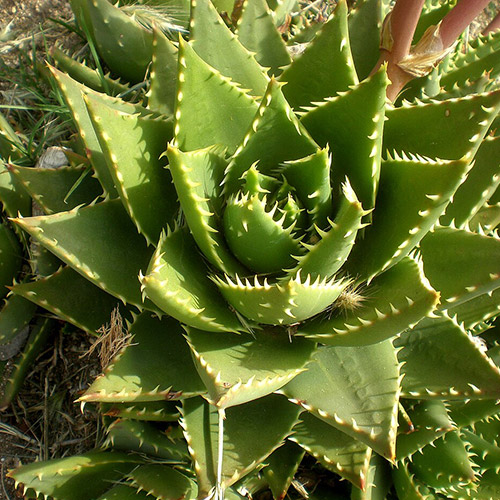📷 Consultaplantas, wikipedia.org
Aloe nobilis aka Gold 🦷Tooth Aloe
Aloe | Updated: February 15, 2025
The golden spines on the edge of this succulent may look mean, but they won’t harm you. Gold-Tooth Aloe has green leaves that can turn orange when stressed or in full sun. It is deer resistant, and attractive to bees and hummingbirds. Watch for red blooms in the summer.
Quick Guide
- Full sun to partial shade 🌤️
- Typical water needs for a succulent
- Plant grows up to 24″ (61 cm) tall
- Plant grows up to 24″ (61 cm) wide
- Zone 9a (Minimum 20° F | -6.7° C)
- Not cold hardy
- Propagation by offsets
- Generally non-toxic to humans and animals
- Summer Dormant
How to 🩷 Care for and Propagate Your 🪴 Succulents
General Care for Aloe nobilis Gold-Tooth Aloe
Aloe nobilis, known as Gold Tooth Aloe, makes a fantastic addition to any succulent container garden, rock garden, or even a terrarium. Don’t worry if you see the tips turning brown – it’s a natural part of its growth. If the brown tips bother you, just break them off.
Watering
Gold-Tooth Aloe has typical watering needs for a succulent. Use the soak and dry method, allowing the soil to dry out completely between waterings.
Where to Plant
Aloe nobilis isn’t cold-hardy. If your area dips below 20°F (-6.7°C), it’s best to plant it in a container you can bring indoors. This succulent thrives in full to partial sun and can also be grown indoors.
How to Propagate Aloe nobilis Gold-Tooth Aloe
Gold-Tooth Aloe is a prolific propagator, producing numerous offsets around its base. To propagate, simply pull up the offsets, let them dry for one to two days, and then replant them.
Often Confused With
Aloe nobilis is often mistaken for Aloe perfoliata. However, Gold-Tooth Aloe is lighter green and smaller in size.
Tags & Attributes
Scientific Classification
Kingdom: Plantae
Clade: Tracheophytes
Clade: Angiosperms
Clade: Monocots
Order: Asparagales
Family: Asphodelaceae
Subfamily: Asphodeloideae
Tribe: Aloeae
Genus: Aloe
Species: A. × nobilis



